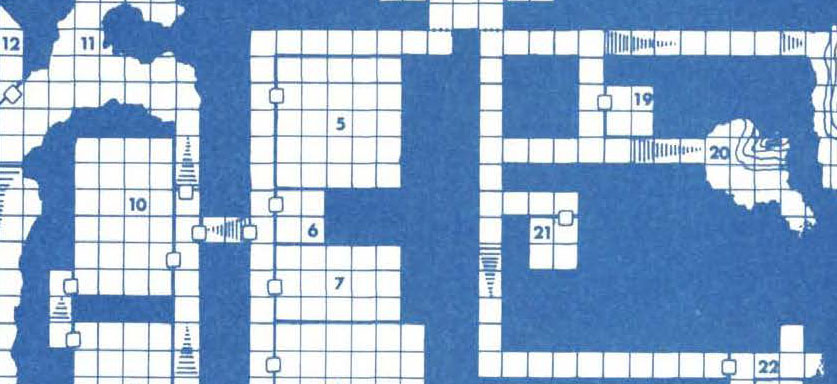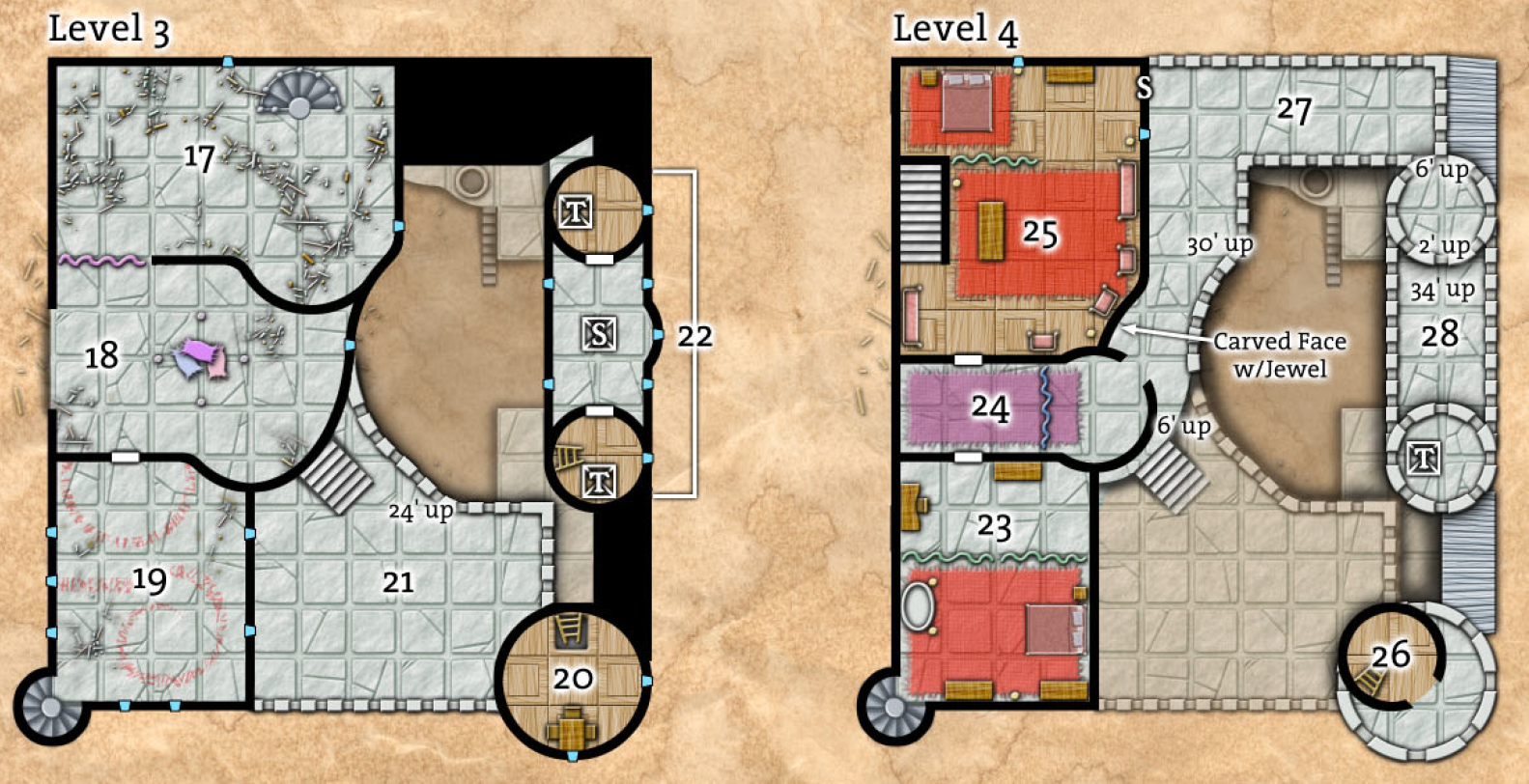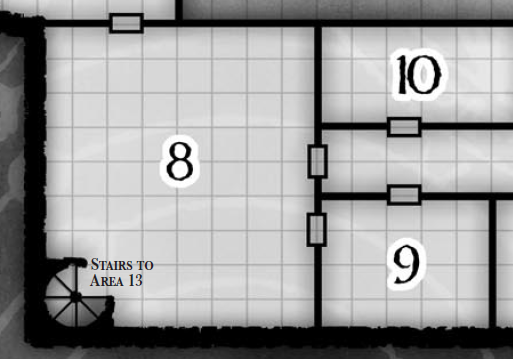DISCUSSING:
In the Shadow of the Spire – Session 22A: Return to Pythoness House
Arrows suddenly fell among them. One of them clipped Elestra’s shoulder. All of them were suddenly in motion – diving for cover in different directions. Somehow six skeletal women – most clad in the tattered remnants of their brothel fineries – had crept onto the upper terrace and were now firing arrows down into the ruined garden at them.
A novice GM looks at the map of the dungeon. The PCs are about to open the door to Area 5, so he checks the key (in this case from B3 Palace of the Silver Princess) and sees that (a) it’s a library and (b) there are five kobolds in the room.
A fight breaks out. If the novice GM is talented, then the events of that fight will be influenced by the details of Area 5: Maybe the bookshelves topple over on top of people and the kobolds are throwing books. But the kobolds are keyed to Area 5, and so that’s where the kobolds are met and where the fight happens.
Time passes and our novice GM has gotten more experience under his belt. This time, when the PCs get ready to open the door to Area 5, he doesn’t just look at the description of Area 5. He looks around the map and checks nearby areas, too, to see if there are other monsters who might come to join the fight. He looks at Area 7, for example, and sees that it’s a barracks for five goblins.
A fight breaks out. The GM makes a check for the goblins in Area 7. He determines that they DO hear the fight, and a couple rounds later they come rushing over and join the melee in the library.
What the experienced GM is doing can be made a lot easier by using adversary rosters in addition to a basic map key. But there are other methods that can be used to achieve similar results. For example, the sounds of combat might increase the frequency of random encounter checks.
Random encounter mechanics might also lead this GM to another revelation: Combat encounters can happen in areas where they weren’t keyed. For example, maybe the PCs are poking around at the sulfur pool in Area 20 when a random encounter check indicates the arrival of a warband of kobolds.
At this point, our more experienced GM has accomplished a lot: Their dungeons are no longer static complexes filled with monsters who patiently wait for the PCs to show up and slaughter them. They feel like living, dynamic spaces that respond to what the PCs are doing.
THE THEATER OF OPERATIONS
There’s still one preconception that our GM is clinging to. He’s likely unaware of it; a subconscious habit that’s been built up over hundreds of combats and possibly reinforced through dozens of modules relying on preprogrammed encounters (even as he’s moved beyond such encounters).
When the goblins came rushing over to join the fight in the library? It was still the fight in the library. When the kobolds ambushed the PCs by the sulfur pools? The GM still thought of that fight as somehow “belonging” to Area 20.
One of the reasons this happens is because our method of mapping and keying a dungeon is designed to do it: We conceptually break the map into discrete chunks and then number each chunk specifically to “firewall” each section of the dungeon. It makes it easier to describe the dungeon and it makes it easier to run the dungeon, allowing the GM to focus on the current “chunk” without being overwhelmed by the totality.
But the next step is to go through that abstraction and come out the other side. We don’t want to abandon the advantages of conceptually “chunking” the dungeon, but we also don’t want to be constrained by that useful convention, either.
When combat breaks out, for example, we don’t want to be artificially limited to a single, arbitrarily defined “room.” Instead, I try to think of the dungeon as a theater of operations — I look not just at the current room, but at the entire area in which the PCs currently find themselves.
You can see a very basic version of this in the current campaign journal:
While the PCs are in Area 21: Rooftop Garden, I’m aware that the skeletal warriors in Area 25: Radanna’s Chamber have become aware of them. They sneak out onto Area 27: Battlements and fire down at the PCs, initiating combat across multiple rooms (and, in fact, multiple levels).
Here’s another simple example, the hallway fight from Daredevil:
This is basically just two rooms with a hallway between them. But note how even this simple theater of operations creates a more interesting fight than if it had been conceptually locked to just one of the small 10’ x 10’ rooms individually.
Also note how the encounter actually starts before he even enters the first room. This way of thinking about dungeons goes beyond combat: What’s on the other side of the door they’re approaching? What do they hear? What do they see through the open archways?
LEARNING THROUGH ZONES
Awhile back, I wrote about how abstract distance systems in RPGs mimic the way that GMs think about and make rulings about distance and relative position. Zones — like those used in Fate or the Infinity RPG — are a common example of such a system, and using a zone-based system can also be a great set of training wheels for breaking away from the idea that combat takes place in a single keyed location, because zones naturally invite the GM to think of neighboring rooms as being a cluster of zones.
For example, I have Monte Cook’s Beyond the Veil sitting on my desk here. Here’s a chunk of the map from that scenario:
And Area 8 on that map is described like this
8. DRAGONPODS
This large chamber was once a gathering hall with tables and benches, and trophies on the wall. There are only vague remnants of those now. Instead, the room has a large number of strange brown and yellow pods on the floor, and clinging to the walls and ceiling, each about three to four feet across. Six of them remain unopened, while at least a dozen have burst from the inside. A few smaller dragonpods lie cracked and brittle on the ground, unopened but obviously long-dead. All of the pods are of some hard organic matter covered in a thick, sticky mucus. They smell of sour fruit.
Storemere’s mating with a carrion crawler produced some strange results. Carrion crawlers normally lay hundreds of eggs at a time. But Storamere’s crawler mate produced dozens of strange, egg-like pods. Some of them hatched, and produced half-dragon carrion crawlers. Others never produced anything viable. Still others have yet to hatch, even though their parents are long dead.
Strangely enough, the union of dragon and carrion crawler seems to have spawned a creature with entirely new abilities. These half-breeds thrive for a time and then curl up and die, producing yet another dragonpod. Even if slain conventionally, the body of the dead dragon crawler will create a new pod and thus a new creature. Only destruction by fire prevents a dead specimen from forming into a pod.
As soon as anyone without dragon blood enters the chamber, four dragon crawlers scuttle out from behind the pods and attack. The round after combat starts, another one drops down from the ceiling to attack a random character. These creatures are covered in black scales and have green, dragon-like eyes on their stalks. Each has dragon wings but they are too small and ill-fitting to allow them to fly. Instead, they flutter and flap their wings to distract opponents.
The room is large enough to comfortably run the entire melee against the four dragon crawlers in there. A neophyte GM might even treat the whole room as kind of being a big square, featureless space.
What an experienced GM will do (and what zones basically formalize) is break that whole region of dungeon map up into zones:
- Hallway
- Kitchen (Area 9)
- Gaulmeth’s Chamber (Area 10)
And then do the same in Area 8, too:
- North entrance
- Eastern doors
- Bottom of the stairs
- Dragonpod muck
- Ceiling pods
The result will be their theater of operations. (Which could expand even further into the dungeon depending on how the encounter proceeds.) Thinking in terms of zones will naturally invite you not only to conceptually break up large spaces, but to group spaces together. And once you’ve done this a few times, you’ll realize that you don’t need the specific mechanical structure of zones in order to do this.
OTHER THEATERS OF OPERATION
Thinking in terms of a theater of operations shouldn’t be limited to the dungeon. In fact, it often comes easier in other contexts (in which we haven’t taught ourselves to think in terms of keyed areas), and meditating on how we think about these other examples can often be reflected back into how we think about the dungeon.
For example, one place where GMs often easily think in terms of a theater of operations, even if they don’t in other contexts, is a house. I suspect it’s due to our intimate familiarity with how these spaces work. Think about your own house: Imagine standing in the kitchen and talking to someone in the living room. Or shouting something down the stairs. Or looking up from the couch and seeing what’s happening in the adjacent room.
When we’re talking about the totality of the environment, that’s all we’re talking about. It’s that simple.
At the other end of the scale, there are wilderness environments.
What happens here is that the sheer scale of the wilderness can, paradoxically, cause the theater of operations to similarly collapse into a one-dimensional scope: The forest is vast and, therefore, the entire fight just happens generically “in the forest.” There’s no place for the reinforcements to come from and no capacity of strategic decisions because everything is, conceptually, in a single place — the forest.
The modern over-reliance on battlemaps (particularly battlemaps all locked to a 5-foot scale) tends to exacerbate this problem, limiting the field of battle to a scale that tends to blot out the true theater of operations in the wilderness.
The solution, of course, is to instead embrace the scale of the wilderness. You’re traveling across the plains, but there’s a tree line a few hundred yards away to the north. There’s a family of deer grazing fifty feet over there. There’s a ravine off to your right perhaps a quarter of a mile away that you’ve been paralleling for awhile now. And the goblin warg riders just cleared the horizon behind you. What do you do?
FINAL THOUGHTS
Something I’ll immediately caution against here is getting fooled into making this more formal than it is. If you find yourself trying to prep the “theaters of operation” in your dungeons, then you’ve probably just created another inflexible preconception of the environment. (You’re probably also wasting a lot of prep.) Theaters of operation generally arise out of and are defined by the circumstances of play: What do the PCs know? Where do they go? How have they tipped off the NPCs? What decisions do the NPCs make (often based on imperfect information)?
The point isn’t to try to anticipate all of those things. The point is to learn how to actively play the campaign world; to let the campaign world live in the moment.
The cool thing is that, as you think of the dungeon as a theater of operations and play it as such, you will be implicitly encouraging the players to also think of the dungeon as a totality rather than as a string of disconnected encounters. They’ll start engaging in strategic decision-making not only in combat (“let’s fall back into the hallway!”), but for the exploration of the dungeon as a whole (“can we draw them back into the room with the poison traps and use those to our advantage? can we circle around them? can we split them up?”). And getting the players into this mindset is instrumental in unlocking more complicated scenario structures like heists.
And remember that, as you’ve seen with our examples above, you don’t have to leap straight into juggling massively complicated strategic arenas: Two rooms and a hallway. That’s all it takes to break out of the box.
NEXT:
Campaign Journal: Session 22B – Running the Campaign: In-Jokes
In the Shadow of the Spire: Index















This is excellent.
I’m working on my own encounter/dungeon building system at the moment, so this article came in at the perfect time.
For those of us who are creating combat scenarios from scratch, Would you advise building theaters of operations from the inside out:( figuring out the combatants and a likely centerpiece of the fight, then creating surrounding rooms to supplement it) OR the outside-in: (building the dungeon zone completely and then choosing likely encounters to take place in different areas)
Most of your examples highlight the best ways to use pre-constructed areas, so I’m curious if you have any insights/advice for those who are starting from a blank canvas
Is the last paragraph of your Dragonpod text block actually meant to be part of your text, or is it still part of the Beyond the Veil quote?
@Kalyptein: Fixed! Thanks!
@Elias: Generally speaking, I design strategically. But I start at a basic level of, “Why does this space exist?” Insofar as the NPCs in that space are set up for cool fights, it’s because the NPCs themselves are motivated to be prepared for a fight (i.e., security patrols and the like).
My process is a lot more like creating a building and then, as an almost completely separate step, doing fight choreography in the building that I built.
My general rule of thumb is that if you make a building full of cool shit, there’ll almost certainly be some cool way you can use that space in the game.